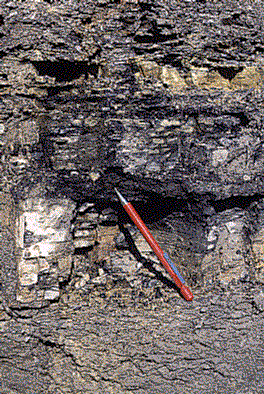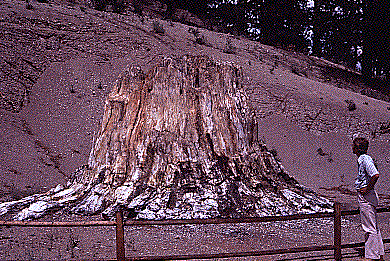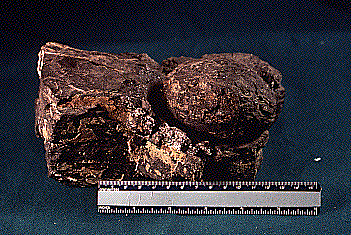Permineralization
Fossils: Window to the pastPermineralizationWhat is permineralization?A common form of fossilization is permineralization. This occurs when the pores of plant materials, bones, and shells are impregnated by mineral matter from the ground, lakes, or oceans. In some cases, the wood fibers and cellulose dissolve and are replaced minerals. Sometimes the mineral substance of the fossils will completely dissolve and other minerals replace them. Common minerals that form this kind of fossil are calcite, iron, and silica. The fossils take the original shape of the tissue or organism as the pores of the organic tissues are filled with minerals, or the organic matter is replaced with minerals. However, the composition of the fossils will be different and they will be heavier.
The process of permineralizationGround water generally does not contain solely pure water molecules. This water can be "hard", meaning containing some minerals. The degree of hardness varies. The different minerals are found in the ground, and water dissolves them until saturation. At this point, water will not hold any additional mineral matter. This process is enhanced by the acidification of the water. For example, rain water may be pure in the beginning, but picks up carbon dioxide from air and becomes a weak carbonic acid. The organic matter in the ground, and other decaying materials also will make ground water more acidic. This acidic water dissolves more minerals. Organic tissues like wood, bone, and shell contain pores and spaces. The mineralized water fills the pores of the organic tissues and moves through the cellular spaces. During this process the saturated water evaporates, and the excess minerals are deposited on the cells and tissues. This process creates many layers of mineral deposits creating hard fossilized record. What can we tell from permineralization?
There are three subgroups of permineralizations: silicification, pyritization, and carbonate mineralizations. As with almost all fossilization processes, silicification (because of its conditions for fossilization) tells us much about what type of environment the organism was likely to live in. Specific fossil types occur in environments with certain features. Silicification is a fossilization process whereby the organism is penetrated by minerals that form on the cells and cell structures. In this case, the mineral is silica, and because the mineral "follows" the internal structures of the organism during mineralization. This accounts for the amazing amount of detail found in permineralizations. For example, (for silicification) fluids in volcanic terrain often contain silica that could be absorbed by the plants themselves. This would indicate that a volcano was near the plant in the past. An interesting point that this example presents is that the plant was already beginning its fossilization process when it was still living. The silica that is taken up by the plants become embedded within them and when they die, the material (silica) is already present within them to quickly mineralize the organism and fossilize it. In this way, the silicification process can often show very fine detail.
Carbonate mineralizations occur both in marine and nonmarine environments. The most popular forms of carbonate mineralizations that are cited in biology are what are called "coal balls." Coal balls (which are often found in a round ball shape, which gives them their name) are often a fossilization of many different plants and their tissues. Often, they occur in the presence of seawater or acidic peat. Acetate peels can also usually be made to study the various organic material trapped within a coal ball. These peels may sometimes be fairly revealing of cellular detail. |
 Petrification
occurs when the organic matter is completely replaced by minerals and the
fossil is turned to stone. This generally occurs by filling the
pores of the tissue, and inter and intra cellular spaces with minerals,
then dissolving the organic matter and replacing it with minerals. This
method reproduces the original tissue in every detail. This kind of fossilization
occurs in both hard and soft tissues. An example of this kind of fossilization
is petrified wood.
Petrification
occurs when the organic matter is completely replaced by minerals and the
fossil is turned to stone. This generally occurs by filling the
pores of the tissue, and inter and intra cellular spaces with minerals,
then dissolving the organic matter and replacing it with minerals. This
method reproduces the original tissue in every detail. This kind of fossilization
occurs in both hard and soft tissues. An example of this kind of fossilization
is petrified wood. Since permineralizations of organisms are three-dimensional fossils
with organic matter replaced by minerals, what they mainly tell us are
the about the internal structures of the organisms. The mineralization
process itself helps to prevent tissue compaction, which could distort
the
actual size proportions of the various organs. Permineralizations are also
not "limited" to hard body parts (such as bones or shells), but
can also be found preserving soft body parts. This could be very important
to researchers who wish to look at what life was like in the past in relation
to what it is now in the present. An example: the fragile reproductive
structures of many plants depending on the conditions for the fossilization
process and the specific mineral that was used for the fossilization. However,
varying degrees of detail do exist. Sometimes, only very differentiated
cell types can be distinguished (such as between vascular tissue for conducting
water and nutrients and ground tissue in plants), while in other fossils,
the detail can be so fine as to distinguish between the different organelles
within the various cells.
Since permineralizations of organisms are three-dimensional fossils
with organic matter replaced by minerals, what they mainly tell us are
the about the internal structures of the organisms. The mineralization
process itself helps to prevent tissue compaction, which could distort
the
actual size proportions of the various organs. Permineralizations are also
not "limited" to hard body parts (such as bones or shells), but
can also be found preserving soft body parts. This could be very important
to researchers who wish to look at what life was like in the past in relation
to what it is now in the present. An example: the fragile reproductive
structures of many plants depending on the conditions for the fossilization
process and the specific mineral that was used for the fossilization. However,
varying degrees of detail do exist. Sometimes, only very differentiated
cell types can be distinguished (such as between vascular tissue for conducting
water and nutrients and ground tissue in plants), while in other fossils,
the detail can be so fine as to distinguish between the different organelles
within the various cells. Pyritization involves the mineral sulfur. Many of the plants are thus
pyritized when they are in marine sediments since they often contain a
large amount of sulfur. This could have been their natural habitat in the
past or they could have been near enough to a marine environment to end
up there to be pyritized (after being carried down by a river, flood, or
some other method). Some plants are also pyritized when they are in a clay
terrain, but to a lesser extent than in a marine environment.
Pyritization involves the mineral sulfur. Many of the plants are thus
pyritized when they are in marine sediments since they often contain a
large amount of sulfur. This could have been their natural habitat in the
past or they could have been near enough to a marine environment to end
up there to be pyritized (after being carried down by a river, flood, or
some other method). Some plants are also pyritized when they are in a clay
terrain, but to a lesser extent than in a marine environment.